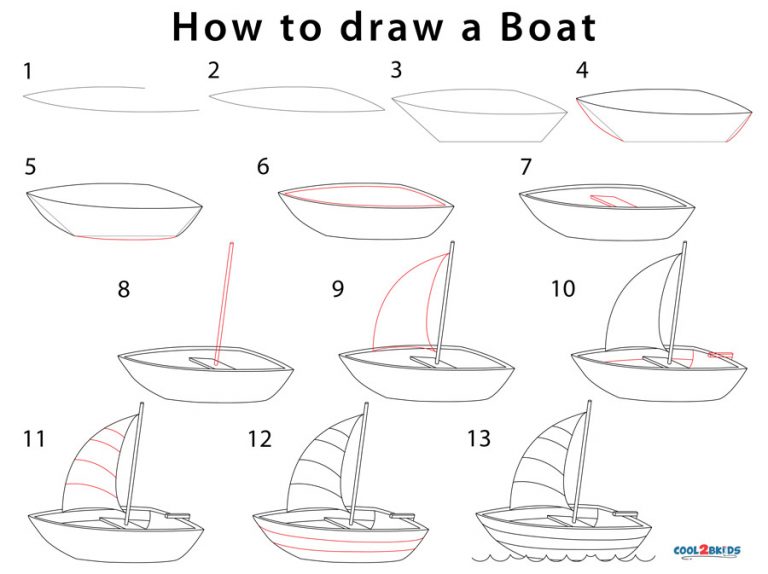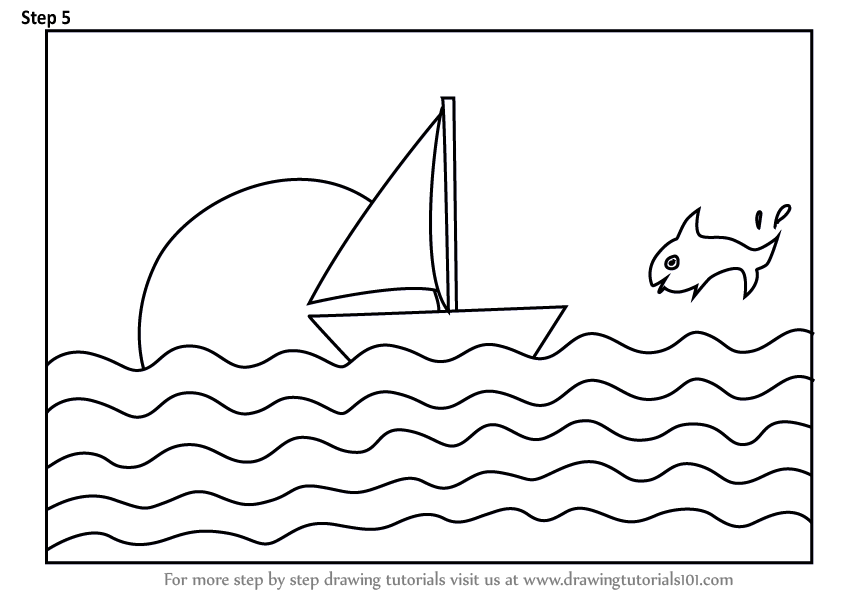Have you ever gazed at a serene harbor with boats gently bobbing on the water and felt the urge to capture that beauty on paper? Drawing a boat can be an incredibly rewarding experience, regardless of your artistic skill level. With a few simple steps and some guidance, you can transform a blank canvas into a captivating nautical scene.

Image: www.cool2bkids.com
Whether you’re a seasoned artist looking for a new creative challenge or a budding artist who wants to learn a new skill, this guide will help you navigate the waters of boat drawing. We’ll delve into the essential elements of boat anatomy, explore various techniques, and guide you through the process of creating your own stunning boat artwork. So, let’s set sail and embark on this artistic adventure together!
The Fundamentals of Boat Anatomy: Building Blocks of Your Artwork
Before we start sketching, let’s familiarize ourselves with the basic parts of a boat. Understanding these components will help you visualize the structure and draw it more accurately:
- **Hull:** The hull is the primary structure of the boat, providing its shape and buoyancy. It’s the main body that floats on the water.
- **Bow:** The front of the boat is called the bow.
- **Stern:** The rear end of the boat is the stern.
- **Deck:** The upper surface of the boat that you walk on is called the deck.
- **Mast:** This is the upright pole that supports the sails.
- **Sails:** These are the large pieces of fabric that catch the wind to propel the boat forward.
- **Keel:** This is the central beam that runs along the bottom of the hull, providing stability and balance.
- **Rudder:** This is the flat, movable part attached to the stern, used to steer the boat.
- **Propeller:** Used on motorboats, the propeller is a rotating blade system that pushes water backward to move the boat forward.
Step-by-Step Guide: From Simple Shapes to Detailed Boats
Let’s dive into the drawing process. We’ll start with a simple boat shape and gradually add details to build a more complex and realistic depiction.
Step 1: Creating the Basic Shape
Grab a pencil and a piece of paper. It’s easiest to begin with a simple rectangular shape to represent the hull of your boat. Draw a long, horizontal rectangle that is slightly wider at the bow (front) than the stern (back). This will give your boat a more realistic profile.

Image: www.drawingtutorials101.com
Step 2: Adding the Deck and Bow
Next, draw a smaller rectangle or trapezoid shape on top of the boat hull to create the deck. This deck will be the main walking area of your boat. Be sure to connect the two pieces smoothly.
Now, round out the front section of the hull. The bow typically has a more curved and rounded shape compared to the rest of the boat’s hull.
Step 3: Drawing the Details
Add the mast if your boat is a sailboat. Draw a vertical line extending from the deck, starting near the middle of the hull. Then, add the rudder at the rear of the boat, extending downward from the stern. It usually resembles a small fin or paddle.
Step 4: Adding Sails or a Motor
If you are drawing a sailboat, sketch the sails, ensuring that they are attached to the mast. Sails come in various shapes and sizes, but a basic triangle shape is a good starting point. If you’re drawing a motorboat, you’ll want to add the motor and propeller at the rear of the boat.
Adding Depth and Dimension: Embracing Techniques
Now let’s enhance our boat drawing with some techniques to make it look more realistic and interesting.
1. Shading for Depth
Shading is a fundamental technique for adding depth and dimensionality to your drawings. It creates an illusion of light and shadow, making your boat appear more three-dimensional. Use your pencil to shade the areas that would be darker, such as underneath the boat and inside the hull, and leave the areas that would be lighter unshaded.
2. Adding Texture
To make your boat appear more textured, use a blending tool, such as a cotton swab or your finger, to gently shade the areas you have darkened, smoothing out the lines to create a textured look. You can also use cross-hatching, a technique that involves drawing parallel lines that intersect to create a shaded or textured effect.
Beyond the Basics: Exploring Unique Boat Styles
Now that we’ve mastered the fundamentals, let’s venture into the world of various boat styles. There’s a boat for every purpose, and each one has its own unique characteristics that make it visually exciting to draw.
1. Sailboats
Sailboats offer a diverse range of styles:
- **Sloops:** These have a single mast and two sails.
- **Ketch:** These have two masts and a smaller sail on the smaller rear mast.
- **Yachts:** Typically luxurious and large.
- **Dinghies:** Small, open boats ideal for rowing or sailing on calmer waters.
2. Motorboats
- **Speedboats:** These sleek and fast vessels are known for their sporty design.
- **Cruisers:** These are designed for comfortable cruising and often have enclosed cabins.
- **Fishing Boats:** These are more practical, with features designed for fishing.
- **Ferry Boats:** Typically large, these carry passengers and vehicles across bodies of water.
3. Traditional Boats
Traditional boats around the world offer a rich source of inspiration. The “Dhow” from the Arabian Peninsula with its distinctive lateen sail, the “Junk” from Asia with its unique multiple masts, and the “Gondola” from Venice, Italy, with its sleek and elegant design, are just a few examples.
Adding the Finishing Touches: Creating a Scene
To make your boat drawing truly captivating, complete your masterpiece by adding a backdrop and contextual elements:
- **Seascapes:** Give your boat a dramatic setting by sketching waves, a calm ocean surface, or a rocky coastline.
- **Harbors and Wharves:** Draw a bustling harbor with other boats, buildings, and people.
- **Birds in Flight:** Add a sense of motion by including birds soaring above the water.
Beyond Pencil and Paper: Experimenting with Media
For a more vibrant and colorful approach, you can use colored pencils, crayons, markers, or even paint to bring your boat drawing to life. Experiment with different techniques to find your preferred approach.
How To Draw A Boat Easily
https://youtube.com/watch?v=MgPjJlMx44o
Conclusion: Charting Your Course in Art
Drawing a boat is an exciting journey of creativity and skill-building. By starting with basic shapes and adding details step-by-step, you can create stunning boat artwork that captures the beauty of the sea and the thrill of nautical adventure. Whether you choose to draw a traditional sailboat, a sleek speedboat, or a unique craft from around the world, remember that the most important element is your personal artistic expression. Let your imagination be your compass, and enjoy the rewarding process of bringing your boat designs to life.






